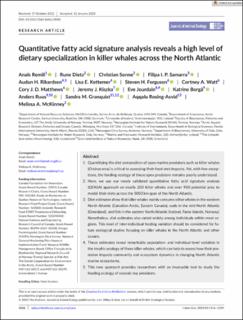| dc.contributor.author | Remili, Anaïs | |
| dc.contributor.author | Dietz, Rune | |
| dc.contributor.author | Sonne, Christian | |
| dc.contributor.author | Samarra, Filipa I. P. | |
| dc.contributor.author | Rikardsen, Audun H. | |
| dc.contributor.author | Kettemer, Lisa Elena | |
| dc.contributor.author | Ferguson, Steven H. | |
| dc.contributor.author | Watt, Cortney A. | |
| dc.contributor.author | Matthews, Cory J. D. | |
| dc.contributor.author | Kiszka, Jeremy J. | |
| dc.contributor.author | Jourdain, Eve Marie | |
| dc.contributor.author | Borgå, Katrine | |
| dc.contributor.author | Ruus, Anders | |
| dc.contributor.author | Granquist, Sandra M. | |
| dc.contributor.author | Rosing-Asvid, Aqqalu | |
| dc.contributor.author | McKinney, Melissa A. | |
| dc.date.accessioned | 2023-07-27T13:30:23Z | |
| dc.date.available | 2023-07-27T13:30:23Z | |
| dc.date.created | 2023-05-04T11:05:29Z | |
| dc.date.issued | 2023 | |
| dc.identifier.citation | Journal of Animal Ecology. 2023, 91 (6), 1216-1229. | en_US |
| dc.identifier.issn | 0021-8790 | |
| dc.identifier.uri | https://hdl.handle.net/11250/3081651 | |
| dc.description.abstract | 1. Quantifying the diet composition of apex marine predators such as killer whales
(Orcinus orca) is critical to assessing their food web impacts. Yet, with few excep-
tions, the feeding ecology of these apex predators remains poorly understood.
2. Here, we use our newly validated quantitative fatty acid signature analysis
(QFASA) approach on nearly 200 killer whales and over 900 potential prey to
model their diets across the 5000 km span of the North Atlantic.
3. Diet estimates show that killer whales mainly consume other whales in the western
North Atlantic (Canadian Arctic, Eastern Canada), seals in the mid-North Atlantic
(Greenland), and fish in the eastern North Atlantic (Iceland, Faroe Islands, Norway).
Nonetheless, diet estimates also varied widely among individuals within most re-
gions. This level of inter-individual feeding variation should be considered for fu-
ture ecological studies focusing on killer whales in the North Atlantic and other
oceans.
4. These estimates reveal remarkable population- and individual-level variation in
the trophic ecology of these killer whales, which can help to assess how their pre-
dation impacts community and ecosystem dynamics in changing North Atlantic
marine ecosystems.
5. This new approach provides researchers with an invaluable tool to study the
feeding ecology of oceanic top predators. | en_US |
| dc.language.iso | eng | en_US |
| dc.publisher | Wiley | en_US |
| dc.rights | Navngivelse 4.0 Internasjonal | * |
| dc.rights.uri | http://creativecommons.org/licenses/by/4.0/deed.no | * |
| dc.title | Quantitative fatty acid signature analysis reveals a high level of dietary specialization in killer whales across the North Atlantic | en_US |
| dc.type | Peer reviewed | en_US |
| dc.type | Journal article | en_US |
| dc.description.version | publishedVersion | en_US |
| dc.rights.holder | © The Authors 2023 | en_US |
| dc.source.pagenumber | 1216-1229 | en_US |
| dc.source.volume | 91 | en_US |
| dc.source.journal | Journal of Animal Ecology | en_US |
| dc.source.issue | 6 | en_US |
| dc.identifier.doi | 10.1111/1365-2656.13920 | |
| dc.identifier.cristin | 2145387 | |
| cristin.ispublished | true | |
| cristin.fulltext | original | |
| cristin.qualitycode | 2 | |

